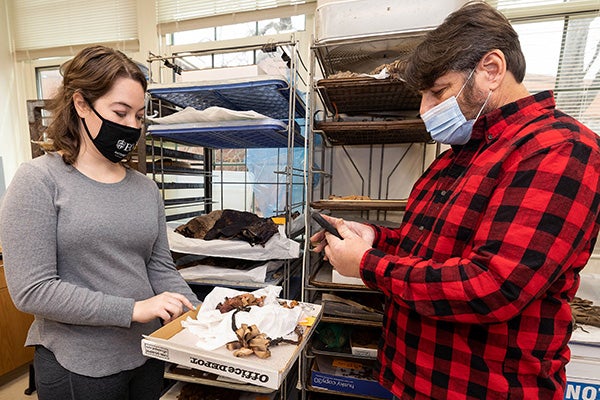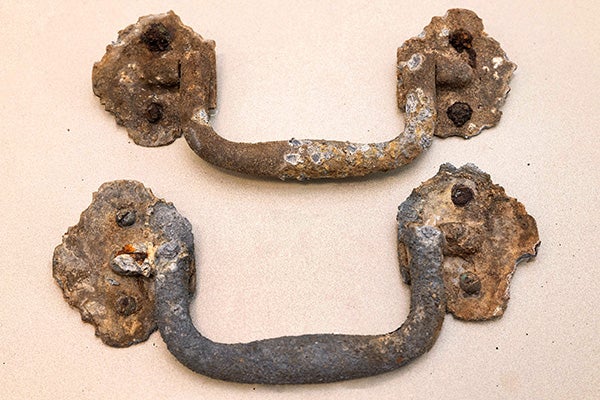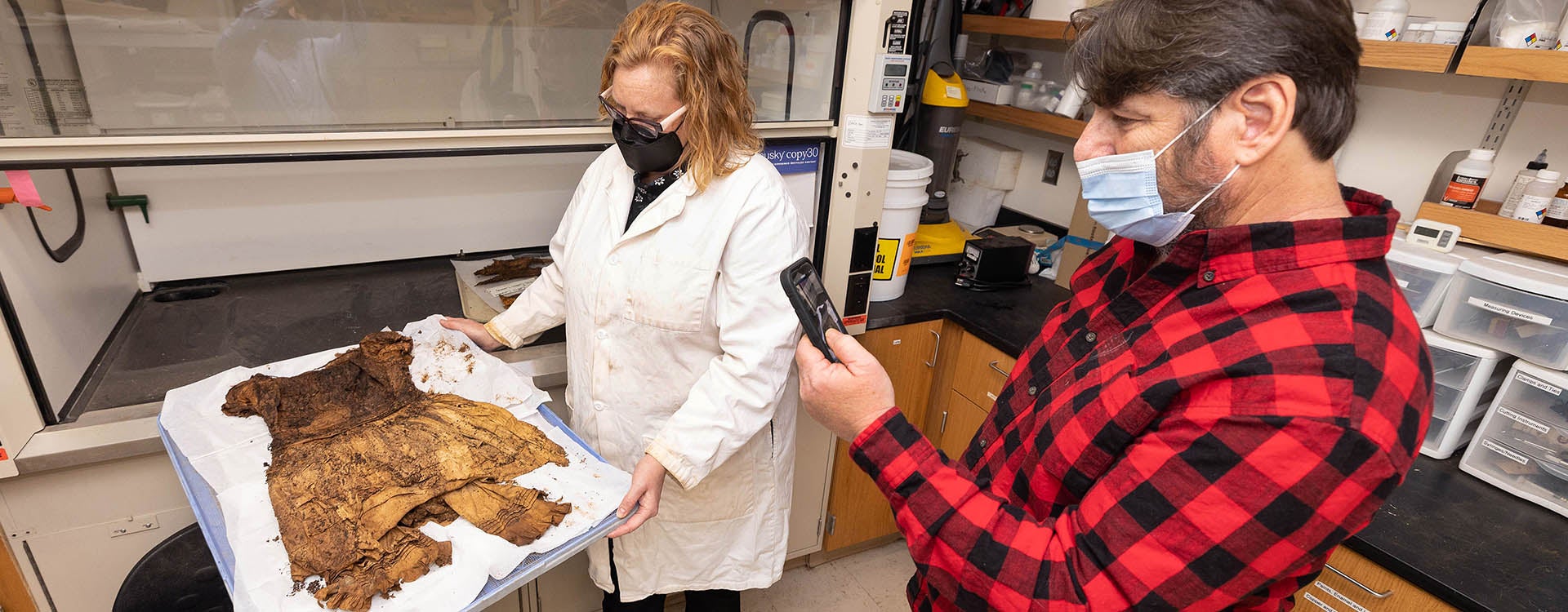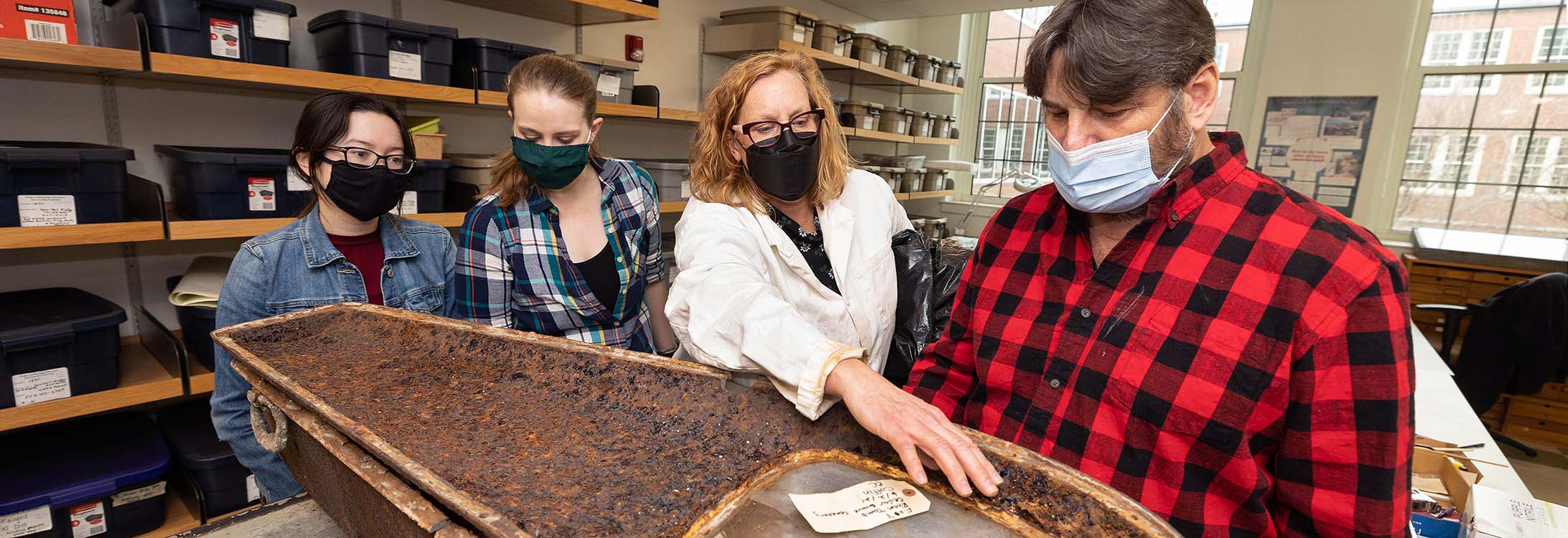ANCESTRAL TOMB RESEARCH
ECU Anthropology graduate students receive real-world skills, keep family’s stories alive
East Carolina University faculty and graduate students in the Thomas Harriot College of Arts and Sciences’ Department of Anthropology are acquiring real-world skills through a project involving an ancestral tomb more than 160 years old.
David French and Michael Miller, cousins and descendants of Joseph Lane Rhem Sr. (1825-1901), who was the owner of a turpentine distillery and steam sawmill, approached ECU asking for assistance in excavating the family tomb in New Bern’s Cedar Grove Cemetery to prepare it for renovation. The tomb had fallen into disrepair due to time, potential break-ins, and a leaking roof that caused most of the wooden caskets to deteriorate, leaving metal caskets and one metal urn in disarray.

Graduate student Jalynn Stewart shows Miller a corsage that was recovered from the family’s tomb.
Deborah Cordes Porcelli — a cousin who now resides in Pennsylvania and is the closest living relation of Rhem Sr. — remembers as a child that her mother would tell her about her grandmother. Her grandmother, who owned a flower shop, would place a corsage in the tomb each year on one of the deceased women’s birthdays.
“I am very interested in the findings from this investigation and learning more about my family’s history,” Porcelli said. “It is a comfort to know that the bones will no longer be mismatched and organized in a way that the family’s story may be told.”
Dr. Megan Perry, anthropology professor, led a team in the process of excavating the Rhem ancestral tomb in summer 2021. Now, Perry is directing research being performed by four anthropology graduate students who are working on the remains and coffins in her lab.
“This is a fantastic opportunity for our students to gain essential field and laboratory skills and help the community at the same time,” Perry said.
Family ties
Seventeen family members from five generations of the Rhem family, beginning with Rhem Sr. — nine adults and eight children — are thought to have resided in the tomb. Although family stories suggest the number may be higher, no evidence is available to verify the existence of other remains. The final descendent of the Rhem family thought to be interred in the tomb is Carolyn Rhem Waldrop Hinnant, who died in 1993.
Sandy Girton, a cousin and descendant of the Rhem family, has been researching the family for many years.
“I remember going to the vault and my mom explaining a Rhem relative was buried there. Little did I know, there were a lot of Rhem relatives buried there,” she said.
She remembers being told that one of the family’s brothers went to Kinston and one went to New Bern. It wasn’t until about 15 years ago, when she had more time for genealogy, that her knowledge expanded.
“Joseph Rhem was the brother of my great grandfather, John Rhem, who lived in the Sand Hill Township of Lenoir County,” she said.
French, who approached ECU with the project, originally thought he was connected to the Rhem family through marriage. He soon learned that Mary Rhem, part of the German Palatines who settled New Bern in 1710, and Nicholas Isler, part of a Swiss family from Bern, Switzerland, are his eighth-great-grandparents.
In February, French’s cousin, Miller, visited Perry’s lab to see how the project was progressing and to learn what she and her students had uncovered. He wanted to report back to French and other family members unable to come to campus.
Gaining skills
Anthropology graduate students Bridget Cone and Jalynn Stewart are performing research and applying specific skills within this project to use for their master’s theses. They also presented their findings during ECU’s Research and Creative Achievement Week and at Anthropology After Dark, hosted by the department.
Cone is performing skeletal analysis of the remains. She is investigating how childhood environments and socioeconomic status of a family from the urban southeastern United States during the 1850s to 1970s affect growth and development, and the risk of disease and death.

Stewart is analyzing hardware for her thesis, including these handles recovered from a coffin.
“I am comparing signs of early life stress and disease from teeth and skeletal remains to those of a rural land-owning family to identify rural and urban differences in juvenile health and its impact on health and disease into adulthood,” Cone said. “One of these skeletal stressors includes evidence of metabolic disease, such as rickets and scurvy, due to Vitamin C and Vitamin D deficiency, respectively.”
Cone presented her research at the conference for the American Association of Biological Anthropology in March. After completing her degree this summer, she plans to join her partner in Chicago where she’ll work as a research associate and data analyst in public health.
Stewart, who presented her research at the Society of American Archeology annual conference in March, is analyzing the coffin hardware for the Rhem family descendants.
“A large part of my thesis is identifying and matching the coffin hardware — handles, thumbscrews, viewing plates, etc. — to other excavations and 19th-century hardware catalogs. Unique hardware can be matched to manufacturing catalogs and used to date the burial,” Stewart said. “Artifacts in the family tomb have helped us identify individuals that were not originally linked to the family. These items include nameplates, a headstone, a medical ID bracelet and dentures. This is an important step, as we found almost twice as many individuals inside the vault compared to who the Rhem family thought was inside.”
Stewart plans to graduate this summer and work for a company that performs contract archeology or cultural resource management. She wants to use her geographic information science certificate to digitally map and analyze archeological sites.
While data collection and analysis continue, first-year anthropology graduate students Ceara Nicholson and McClean Pink are acquiring valuable, real-world research experience.
“As a first-year graduate student, I came into the project after coffins had been relocated from the vault to our labs at ECU,” Nicholson said. “McClean and I assisted with artifact cleaning, osteological inventory and several coffin excavations our first semester.”
According to Nicholson, her previous lab experience is beneficial to this project.
“I have field experience in mortuary archaeology and have taken courses in human osteology, which have been very helpful for data collection and skeletal inventory of the comingled (intermingled) remains,” she said.
Repair and preserve
Nicholson and Pink both agree that the project is proving to be a positive benefit for the family.
“When speaking with the descendants, there seems to be a definite sense of connection to the deceased, regardless of their biological relationship. I think the process has allowed the family to dig deeper into their history and bring the family together in a shared cause,” Nicholson said.
“From the time I have spent with the family, it seems they are very excited about learning more about who was buried in the vault and what caused their deaths,” Pink said. “I am always supportive of projects that include public involvement in archaeological projects and helping families connect to their ancestry.”
After completing her master’s degree, Nicholson would like to pursue a doctorate and specialize in paleopathology. Pink, whose thesis work will focus on Perry’s Petra North Ridge Project, hopes to continue research in the Near East, focusing on archaeology and mortuary analysis. She also plans to further her education by pursuing a doctorate.
All the cousins and descendants of the family have stated their main goal is to preserve and repair the resting place of the Rhem Family vault so the remains may be safely returned.
“All the ECU staff and students have been wonderful. They have been very respectful in the handling of the remains and have been very willing to share any information regarding their findings,” Girton said. “We will always be thankful for ECU’s involvement and the kindness that has been shown to the family members.”
French said, “It has been absolutely wonderful working with Dr. Perry, Dr. Ewen, Bridget, Jalynn and all the students. We are so thankful and appreciative that they were available and willing to take on this project.”
“This is our third bioarchaeological project focusing on burial vaults in 18th– and 19th-century eastern North Carolina that has been instigated by the descendants as part of a grave renovation project,” Perry said. “As people become interested in their family’s genealogy and history, they recognize the wealth of information that the study of human remains provides about their ancestors.”

Perry talks about a dress recovered from the tomb.
